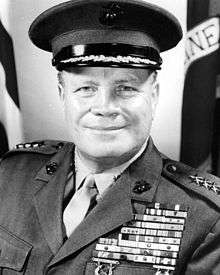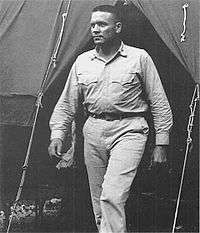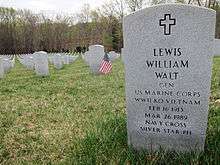Lewis William Walt
| Lewis William Walt | |
|---|---|
 General Lew Walt, U.S. Marine Corps | |
| Nickname(s) |
Lew Silent Lew Uncle Lew[1] |
| Born |
February 16, 1913 Wabaunsee County, Kansas |
| Died |
March 26, 1989 (aged 76) Gulfport, Mississippi |
| Place of burial | Quantico National Cemetery |
| Allegiance |
|
| Service/branch |
|
| Years of service |
1930–1936 (Colorado National Guard) 1936–1971 (USMC) |
| Rank |
|
| Commands held |
2nd Battalion 5th Marines 3rd Battalion, 5th Marines 5th Marine Regiment The Basic School 3rd Marine Division Assistant Commandant of the Marine Corps (1968–1971) |
| Battles/wars |
World War II *Tulagi *Battle of Guadalcanal *Battle of Cape Gloucester Korean War Vietnam War |
| Awards |
Navy Cross (2) Distinguished Service Medal (2) Silver Star Medal Legion of Merit with Combat "V" Bronze Star Medal with Combat "V" Purple Heart Medal (2) Combat Action Ribbon (3) |
Lewis William Walt (February 16, 1913 – March 26, 1989), also known as Lew Walt, was a retired United States Marine Corps four-star general who had served in World War II, the Korean War, and the Vietnam War. Walt was decorated several times, he was awarded two Navy Crosses for extraordinary heroism during World War II, one for leading the attack on "Aogiri Ridge" during the Battle of Cape Gloucester (New Britain); the ridge was renamed "Walt's Ridge" in his honor.
Biography
Lewis William Walt was born on February 16, 1913, in Wabaunsee County, Kansas.[2] He graduated from high school in Fort Collins, Colorado. He earned a Bachelor of Science degree in chemistry at Colorado State University in 1936. Highlights of his student activities include: honor graduate, President of Student Body and Student Council, Captain of football team and wrestling team, Cadet Colonel of the ROTC, President of chemistry club and Captain of Scabbard and Blade. He enlisted in the Colorado National Guard at the age of 17. Upon graduation he was commissioned a second lieutenant in the Army Field Artillery Reserve, but resigned that commission to accept an appointment as a Marine second lieutenant on July 6, 1936.
Lieutenant Walt completed The Basic School at Philadelphia, and in April 1937 was assigned to the 6th Marine Regiment in San Diego, California as a machine gun platoon leader. Embarking for China in August 1937, he took part in the defense of the International Settlement of Shanghai until February 1938, at which time he returned to San Diego. In June 1939, he began his second tour of overseas duty when he was assigned to the Marine Barracks, Guam, Mariana Islands. He was promoted to first lieutenant in October 1939.[2]
Returning to the United States in June 1941, shortly before his country's entry into World War II, Lieutenant Walt was assigned as a company commander in the Office Candidates' Class, Marine Corps Schools, Quantico, Virginia. He was promoted to captain in December 1941.[2]
His first marriage to Nancy Mary Sheehan, an Army nurse he met in World War II, ended in divorce. He was survived by his second wife, June Burkett Jacobsen Walt, and two sons and a daughter by his first marriage, Lewis W. Walt Jr., Lawrence C. Walt and Mary K. Martin.[3]
World War II
.jpg)
Early in 1942, Captain Walt volunteered to join the 1st Marine Raider Battalion, and in April 1942 arrived with the battalion on Samoa. On August 7, 1942, as commander of Company A, 1st Raider Battalion, he landed his company in the assault on Tulagi Island in the British Solomon Islands. He was awarded the Silver Star Medal for conspicuous gallantry during this landing. Following this action, he joined the 5th Marines on Guadalcanal where he took part in combat as Commanding Officer of the 2nd Battalion, 5th Marines. He was promoted to major in September 1942.[2]

In October 1942, as Battalion Commander, 2nd Battalion, 5th Marines, 1st Marine Division, Major Walt was wounded in action but continued in combat. On December 22, 1942, he was spot promoted to lieutenant colonel for distinguished leadership and gallantry in action during the Guadalcanal campaign.[2]
In December 1943, following hospitalization and training in Australia, Lieutenant Colonel Walt led the 2nd Battalion, 5th Marines, in the assault at Cape Gloucester, New Britain, and shortly thereafter was assigned as Regimental Executive Officer. In the middle of this campaign he was ordered to take over command of the 3rd Battalion, 5th Marines, during the intense battle for Aogiri Ridge. During this action, he earned his first Navy Cross and Aogiri Ridge was named "Walt Ridge" in his honor by General Lemuel C. Shepherd, Jr., 1st Marine Division Assistant Commander. Departing Cape Gloucester in late February 1944, Lieutenant Colonel Walt was ordered to the Naval Hospital, Oakland, California, for treatment of wounds and malaria.[2]
In June 1944, he returned to the Pacific theater. That September, he landed with the Marine force on Peleliu as Regimental Executive Officer, 5th Marines. On the first day of the battle, he was again ordered to take command of 3rd Battalion, 5th Marines after the battalion's commanding officer and executive officer became casualties. After nightfall on the first day of the battle, three of the battalion's companies had failed to make contact with the command post and their exact whereabouts were unknown. At great risk to himself, Lieutenant Colonel Walt ventured out into enemy-infested territory in the dark of night, accompanied by one Marine, and proceeded to locate the missing companies and direct them to their correct position along the divisional line.[4] For these actions, Lieutenant Colonel Walt was awarded his second Navy Cross for gallantry in action.
In November 1944, Lieutenant Colonel Walt returned to the United States, and the following month assumed duty at Marine Corps Schools, Quantico, as Chief of the Marine Officer Candidates' School Tactics Section.
Post-World War II
Assigned to Camp Pendleton in January 1947, Lieutenant Colonel Walt served as Assistant Chief of Staff, G-3, 3rd Marine Brigade, and then as G-3, 1st Marine Division. In November 1947, he assumed duty as Operations and Training Officer, 1st Provisional Marine Brigade on Guam, and later served as Chief of Staff of that organization from February to April 1949. Returning to Marine Corps Schools, Quantico, in May 1949, he saw duty as a battalion commander with the Special Training Regiment; and in September, he entered the Amphibious Warfare School, Senior Course. On completing the course in June 1950, he remained at Marine Corps Schools to serve as Chief of Tactics Section, S-3, and finally, Executive Officer, The Basic School. He was promoted to colonel in November 1951.
Korean War
Colonel Walt was ordered to Korea in November 1952. He was in combat with the 1st Marine Division until August 1953, serving consecutively as Commanding Officer, 5th Marines, Assistant Chief of Staff, G-3, and Chief of Staff of the Division. He received both the Legion of Merit with Combat "V" and the Bronze Star Medal with Combat "V", for exceptionally meritorious service during this assignment. The Republic of Korea government also awarded Colonel Walt the Ulchi Medal and the Ulchi Medal with Silver Star for this period of service.
Post-Korea
On arrival at Marine Corps Schools, Quantico, in August 1953, Colonel Walt saw duty as Director, Advanced Base Problem Section, Marine Corps Educational Center, through May 1954, followed by duty as Commanding Officer, Officers' Basic School, until August 1956. He also served as a Member of the Advanced Research Group, Marine Corps Educational Center, until June 1957.
Transferred to Washington, D.C., Colonel Walt served as Assistant Director of Personnel until August 1959, then entered the National War College, Washington, D.C.. He completed the course in June 1960.
In July 1960, Colonel Walt began a one-year assignment as Marine Corps Representative on the Joint Advanced Study Group of the Joint Chiefs of Staff. Upon completing this assignment, he was promoted to brigadier general and reported for duty at Camp Lejeune as Assistant Division Commander, 2nd Marine Division. In September 1962, General Walt returned to Marine Corps Schools, Quantico, serving as Director of the Marine Corps Landing Force Development Center there until May 1965.
Vietnam War
That same month, he was promoted to major general, and in June 1965 assumed command of III Marine Amphibious Force and 3rd Marine Division in Vietnam. He was also Chief of Naval Forces, Vietnam and Senior Advisor, I Corps and I Corps Coordinator, Republic of Vietnam.
Ten months later, General Walt was nominated for lieutenant general by President Lyndon B. Johnson, and his promotion was approved by the Senate on March 7, 1966. He continued in Vietnam as Commanding General, III Marine Amphibious Force, and Senior Advisor, I Corps and I Corps Coordinator, Republic of Vietnam. During this period, General Walt was awarded his first Distinguished Service Medal. In addition, the Vietnamese government awarded General Walt the Vietnamese National Order, 3rd Class; the Vietnamese National Order, 4th Class; the Gallantry Cross with Palm; the Chuong My Medal, and the Vietnamese Armed Forces Meritorious Unit Citation of Gallantry Cross with Palm. He was also awarded the senior Ulchi Medal by the Government of South Korea.
As a testament to his vital role in Vietnam, Life magazine featured General Walt in a May 1967 cover story. The article noted the success of an innovative program initiated by General Walt in August 1965 called the Combined Action Program (CAP). This program consisted of squads of Marine and Navy medical corpsmen volunteers for combined action platoons (CAP), that were part of combined action companies (CAC), combined with South Vietnamese Popular Force platoons, which were sent into South Vietnamese countryside villages and hamlets to deny the Vietcong access to the people living there. As Life noted, "His CAC units all had the same orders: help protect the villages, get to know the people, find the local Communist infrastructure and put it out of business." General Walt stressed the importance of using combine action companies to win the confidence of average, ordinary Vietnamese citizens. The magazine observed, "If these people could be located and won over, Walt argued, the Communists would be hit where it hurts." Because of the Combined Action Program, the number of "secure" villages under General Walt's protection rose between 1965 and 1967 from 87 to 197, while the number of Vietnamese living in "secure" areas in general rose from 413,000 to 1.1 million.[5]
Assistant Commandant

Upon his return to the United States, General Walt saw duty from June 1967 until the following December as Deputy Chief of Staff (Manpower)/Director of Personnel, at Headquarters Marine Corps. On January 1, 1968, he was designated Assistant Commandant of the Marine Corps.
In April 1969, the Senate passed and sent to the White House a bill to make the Assistant Commandant of the Marine Corps a four-star general when the active duty strength of the Marine Corps exceeds 200,000. On May 5, President Richard M. Nixon signed the bill, and General Walt was promoted to four-star rank on June 2, 1969, thus becoming the first Assistant Commandant of the Marine Corps to attain that rank.
While visiting the Taiwan Defense Command in April 1970, General Walt was presented the Order of the Cloud and Banner with Grand Cordon, by General Kao Kuei-yuan of the Republic of China. Presented by the Chief of the General Staff, the citation recognized the Assistant Commandant's "exceptionally meritorious conduct in the performance of outstanding service to the Chinese Marine Corps." The citation noted that General Walt had "contributed immensely in the furtherance of military cooperation and traditional friendship between the United States of America and the Republic of China."
Retirement


General Walt retired from active duty on February 1, 1971 and subsequently served as Director of the United States Marines Youth Foundation. He later coordinated a U.S. Senate investigation on international drug trafficking. In the mid-1970s General Walt served as the senior military member of President Gerald Ford's clemency board, and he later advised the Department of Defense on weapons development and combat training.[6]
General Walt died on March 26, 1989 at a retirement home in Gulfport, Miss., after a long illness and is buried in Quantico National Cemetery.[7] General Walt, who wrote three books after retiring from the Marine Corps, described the contradictions of the Vietnam War in an article for The New York Times in 1971. On the one hand it was an extremely sophisticated war, with complex weapons unlike even World War II or Korea, he wrote. On the other hand it was a return to medieval war, pitting man against man on a battleground where only the courageous could win. News Media Role Cited
General Walt's three books were Strange War, Strange Strategy, about the war in Vietnam; America Faces Defeat, about the dangers confronting the nation; and The Eleventh Hour, about the urgency of the nation's problems.
Military awards
General Walt's military decorations and awards include:
See also
References
- This article contains text in the public domain from the United States Marine Corps.
- ↑ SimmonsThe US Marines History, p. 224.
- 1 2 3 4 5 6 "Official Biography: General Lew Walt" (PDF). USMC. Retrieved May 15, 2014.
- ↑ Halloran, Richard (March 28, 1989). "Lewis W. Walt, Marine Corps General, Dies at 76". New York Times. Retrieved 2011-01-04.
- ↑ Sledge, E.B. With the Old Breed: At Peleliu and Okinawa. New York: Presidio Press, 1981.
- ↑ Colin Leinster (May 26, 1967). "The Two Wars of General Walt". LIFE Magazine. pp. 83–84.
- ↑ McDonald, Congressman Lawrence Patton, General George S. Patton, USA (retired), and General Lewis W. Walt, USMC (retired) (1983). ""The Authors"". The Swiss Report. Western Goals.
- ↑ "U.S. Department of Veterans Affairs Gravesite Locator".
Bibliography
- Simmons, Edwin H. (2003). The United States Marines: A History, Fourth Edition. Annapolis, Maryland: Naval Institute Press. ISBN 1-59114-790-5.
Web
- "General Lewis W. Walt, USMC". Who's Who in Marine Corps History. History Division, United States Marine Corps. Retrieved 2007-10-29.
- "Lewis William Walt, General, United States Marine Corps". Arlington National Cemetery. Archived from the original on 2006-06-18. Retrieved 2006-07-27.
External links
- Halloran, Richard (March 28, 1989). "Lewis W. Walt, Marine Corps General, Dies at 76". New York Times. Retrieved 2007-10-29.